The project of a strategic cruise missile SLAM (USA). Flying Scrap
First stages
By the mid-fifties, a specific situation had developed in the field of strategic armaments and means of delivery. Due to the development of air defense systems, the bombers lost their potential, and ballistic missiles still could not show a comparable range. It was necessary to further improve missiles and airplanes or develop other areas. In the United States at the time there was a simultaneous study of several different concepts at once.
In 1955, a proposal was made to create a new strategic cruise missile with special capabilities. This product was supposed to break through the enemy's air defense system due to supersonic speed and low altitude. It was necessary to provide the possibility of autonomous navigation at all stages of the flight and the possibility of delivering high-power thermonuclear warheads. Separately, the presence of a communication system was specified, which makes it possible to withdraw an attacking missile at any moment of flight.
The development of a new concept started several US aircraft manufacturing companies. Ling-Temco-Vought launched its project with the working title SLAM, BOLO was named as a similar product in North American, and Convair launched the Big Stick project. Over the next few years, the development of three projects proceeded in parallel; some state scientific organizations were involved in it.
Quickly enough, the designers of all the firms participating in the program faced a serious problem. The creation of a high-speed low-altitude rocket had special requirements for the propulsion system, and a large range to the fuel supply. A rocket with the required characteristics was unacceptably large and heavy, which required radical solutions. By the beginning of 1957, the first proposals appeared on equipping new missiles with direct-flow nuclear jet engines.
At the very beginning of 1957, the Lawrence Radiation Laboratory (now Livermore National Laboratory) was connected to the program. She had to study the problems of nuclear engines and develop a complete sample of this kind. Work on the new power plant was carried out under the program, code-named Pluto. The head of "Pluto" appointed Dr. Ted Merkl.
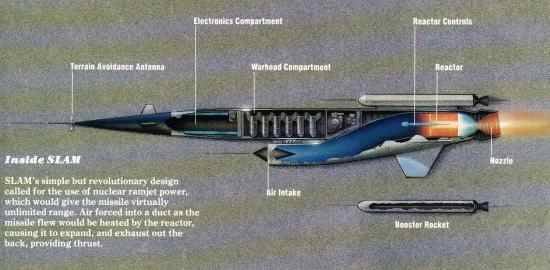
Product layout SLAM. Drawing Merkle.com
In the future, there was a simultaneous work on a promising engine and three types of cruise missiles. In September 1959, the Pentagon determined the best version of the new weapons. The winner of the competition was the company Ling-Temco-Vought (LTV) with the project SLAM (Supersonic Low-Altitude Missile - "Supersonic Low-Altitude Rocket"). It was she who had to complete the design, and then build experienced test rockets and later start mass production.
SLAM project
Special requirements were imposed on new weapons, which led to the need to apply the most daring solutions. Specific proposals appeared in the context of the airframe, the engine and even the payload and the method of its application. However, all this allowed to fulfill customer requirements.
LTV offered a “duck” cruise missile with a length of about 27 m and a take-off weight of about 27,5 t. It was planned to use a large elongated fuselage, in the forward part of which the forward tail was placed, and in the center and tail there was a small delta wing. Under the fuselage, at an angle to the longitudinal axis, there was a protruding air intake bucket. On the outer surface of the rocket should be installed starting solid-fuel engines.
According to the calculations, the cruising flight speed was supposed to reach M = 3,5, and the main part of the trajectory had an altitude of just 300 m. At that, it was planned to rise to altitude up to 10,7 km and acceleration to M = 4,2 speed. This led to serious thermal and mechanical loads and placed special demands on the glider. The latter was proposed to be assembled from heat-resistant alloys. Also, some areas of the skin were planned to be made of radio-transparent materials of necessary strength.
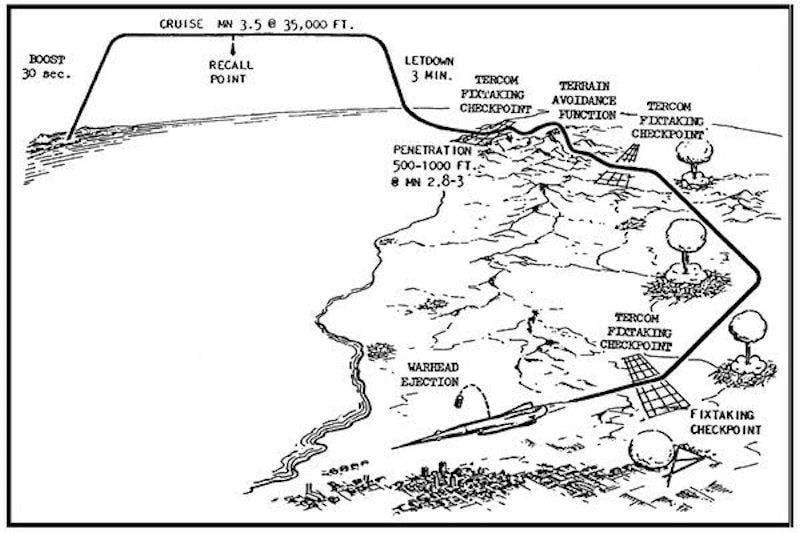
Rocket flight chart. Figure Globalsecurity.org
Engineers eventually managed to get outstanding strength and stability of the structure, exceeding the existing requirements. Because of this, the rocket got the unofficial nickname “flying scrap”. It is worth noting that this nickname, unlike the other, was not offensive and pointed to the strengths of the project.
A special power unit made it possible to optimize the layout of internal volumes due to the rejection of fuel tanks. The nose of the fuselage was given under the autopilot, guidance equipment and other means. A combat load compartment with special equipment was placed near the center of gravity. The tail part of the fuselage accommodates nuclear propulsion engine.
For guidance of the SLAM missile, the TERCOM type system was responsible. On board the product was proposed to place a radar station review of the area. Automatics had to compare the underlying surface with the reference surface and, on the basis of this, correct the flight path. The teams were issued on the cars nasal rudders. Such tools have already been tested in previous projects and showed themselves well.
Unlike other cruise missiles, the SLAM product was supposed to carry not one combat unit, but 16 separate warheads. Thermonuclear charges with a power of 1,2 Mt were placed in the central compartment of the hull and had to be dropped alternately. Calculations showed that the discharge of a charge from a height of 300 m seriously limits its effectiveness, and also threatens the launch vehicle. In this regard, the original system for shooting warheads was proposed. The unit was asked to shoot up and send to the target along a ballistic trajectory, which allowed the bombing to be carried out at the optimum height, and also left enough time for the missile to leave.
The rocket was supposed to take off from a stationary or mobile launcher with the help of three solid-propellant starting engines. After dialing the required speed could turn on marching. The latter was considered a promising product from the Lawrence laboratory. She had to create a straight-through nuclear engine with the required thrust parameters.
According to calculations, the SLAM rocket with the Pluto engine could have an almost unlimited range. When flying at an altitude of 300 m, the estimated range exceeded 21 thousand km, and at the maximum height reached 182 thousand km. The maximum speed was reached at high altitude and exceeded M = 4.
The LTV SLAM project provided for an original method of combat work. The rocket had to take off with the help of starting engines and be sent to the target or go to a given waiting area. The high altitude flight range allowed launching not only immediately before the attack, but also during a threatened period. In the latter case, the rocket had to remain in a given area and wait for the team, and after receiving it - go to the targets.
The maximum possible part of the flight was proposed to perform at high altitude with high speed. Approaching the zone of responsibility of enemy air defense, the rocket had to descend to the height of 300 m and be sent to the first of the designated targets. When passing next to it, it was proposed to drop the first warhead. Further, the rocket could hit more 15 enemy objects. After the ammunition was consumed, the SLAM product equipped with a nuclear engine could fall on another target and also become an atomic bomb.
Also seriously considered two more options for damage to the enemy. During the flight at speed M = 3,5, the SLAM rocket created a powerful shock wave: during low-altitude flight, it represented a danger to ground objects. In addition, the proposed nuclear engine was distinguished by extremely strong radiation "exhaust", capable of infecting the terrain. Thus, a rocket could harm the enemy by simply flying over its territory. After resetting the 16 warhead, it could continue flying and only after developing nuclear fuel could it hit the last target.
Pluto Project
In accordance with the SLAM project, the Lawrence laboratory was to create a direct-flow engine based on a nuclear reactor. This product was supposed to have a diameter of less than 1,5 m with a length of about 1,63 m. To achieve the desired flight performance, the engine reactor had to show heat output at the level of 600 MW.
The principle of operation of such an engine was simple. The incoming air through the air intake should have flowed directly into the reactor core, heated and thrown through the nozzle, creating thrust. However, the implementation of these principles in practice has proved extremely difficult. First of all, there was a problem with the materials. Even heat-resistant metals and alloys could not cope with the expected heat loads. Part of the metal parts of the core decided to replace ceramics. Materials with the necessary parameters were ordered by Coors Porcelain.
According to the project, the core of a nuclear ramjet engine had a diameter of 1,2 m with a length slightly less than 1,3 m. It was proposed to place on it a ceramic base 465 thousand heat-generating elements, made in the form of ceramic tubes 100 mm long and 7,6 mm in diameter. The channels inside the elements and between them were intended for the passage of air. The total mass of uranium reached 59,9 kg. During engine operation, the temperature in the active zone should have reached 1277 ° C and was kept at this level due to the cooling air flow. A further increase in temperature of only 150 ° could lead to the destruction of the main structural elements.
Dummy samples
The most difficult part of the SLAM project was an unusual engine, and it was he who needed to be tested and refined first. Especially for testing, the Lawrence Laboratory has built a new test facility with an area of 21 square. km One of the first to emerge was a stand for testing direct-flow engines, equipped with compressed air supplies. In the tanks of the stand was 450 t compressed air. Away from the position for the engine placed the command post with a shelter, designed for two weeks of stay of the testers.
The construction of the complex took a lot of time. In parallel, experts led by T. Merklom developed a draft engine for the future rocket, and also created its experimental version for bench tests. In the early sixties, these works led to the appearance of the product, codenamed Tory II-A. On the railway platform placed the engine itself and a large number of auxiliary systems. The dimensions of the engine did not meet the requirements of the customer, but even in this form the prototype could show its capabilities.
14 May 1961, the first and last test run of the Tory II-A engine took place. The engine worked for only a few seconds and developed thrust well below the required one for the rocket. Nevertheless, he confirmed the fundamental possibility of creating a nuclear ramjet engine. In addition, there was a reason for restrained optimism: measurements showed that actual engine emissions are noticeably lower than estimated ones.
According to the results of tests of Tory II-A, the development of an improved engine with the letter “B” began. The new Tory II-B product should have advantages over its predecessor, but it was decided not to build and not to test. Using the experience of two projects, we developed the following poster sample - Tory II-C. This engine differed from the previous prototype in reduced dimensions corresponding to the limitations of the rocket glider. At the same time, he could show characteristics close to those required by the SLAM developers.
In May 1964, the Tory II-C engine was prepared for the first test launch. The check was to take place in the presence of representatives of the Air Force Command. The engine was successfully started, and it worked for about 5 minutes, using the entire air supply on the stand. The product developed 513 MW power and gave out a little less 15,9 tonnes. This was still not enough for the SLAM rocket, but approached the project by the time the nuclear propulsive engine was created with the desired characteristics.
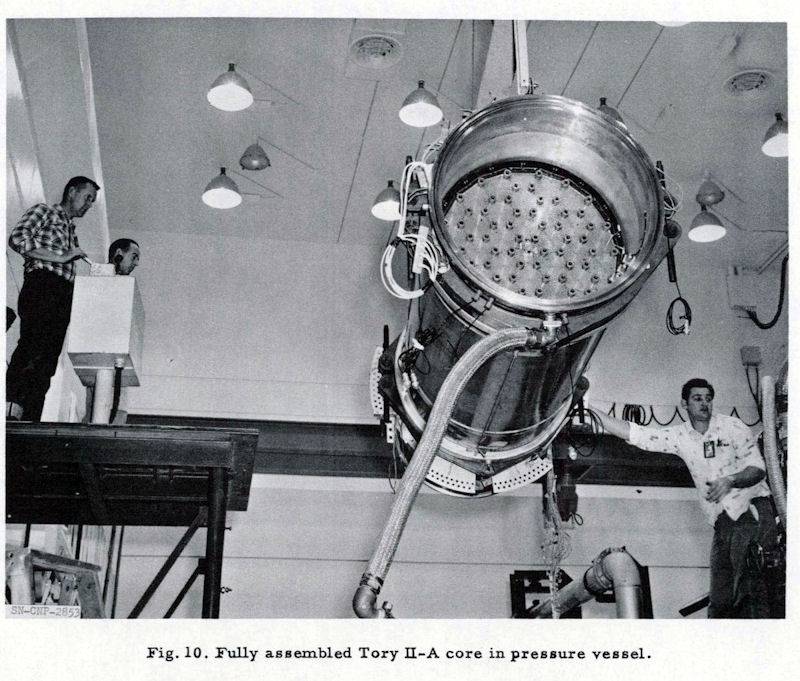
The active zone of the test engine. Photo Globalsecurity.org
Experts noted successful trials in the nearest bar, and the next day they began to work on the next project. The new engine with the working title Tory III had to fully comply with the requirements of the customer and give the SLAM the desired characteristics. According to estimates of that time, an experienced rocket with such an engine could make the first flight in 1967-68.
Problems and disadvantages
Tests of a full-fledged SLAM rocket were still a matter of the distant future, but the customer in the face of the Pentagon already had uncomfortable questions for this project. Both individual components of the rocket and its concept as a whole were criticized. All this had a negative impact on the prospects for the project, and an additional negative factor was the presence of a more successful alternative in the form of the first intercontinental ballistic missiles.
First, the new project turned out to be excessively expensive. The SLAM rocket included not the cheapest materials, but the development of an engine for it became a separate problem for Pentagon financiers. The second complaint was product safety. Despite the encouraging results of the Pluto testing program, the Tory series engines contaminated the area and presented a danger to their owners.
Hence the question of the area for testing future experimental missiles. The customer demanded to exclude the possibility of hitting the rocket in the areas of settlements. The first was a proposal for tethered tests. The rocket was proposed to be equipped with a tether cable connected to an anchor on the ground, around which it could fly in a circle. However, such a proposal was rejected because of obvious shortcomings. Then came the idea of test flights over the Pacific Ocean near Fr. Wake After the development of fuel and the completion of the flight the rocket was supposed to sink at great depth. This option also did not fully suit the military.
Skeptical attitude to the new cruise missile manifested itself in different ways. For example, from a certain time the abbreviation SLAM was deciphered as Slow, Low And Messy - “Slow, low and dirty”, hinting at the characteristic problems of a rocket engine.
1 July 1964, the Pentagon decided to close the SLAM and Pluto projects. They were too expensive and complex, and also not safe enough to successfully continue the work and get the required results. By this time, the program of developing a strategic cruise missile and the engine for it had spent about 260 million dollars (more than 2 billions in current prices).
Experienced engines were disposed of as unnecessary, and all documentation was sent to the archive. However, the projects gave some real results. New metal alloys and ceramics created for SLAM, later found application in various fields. As for the ideas of a strategic cruise missile and a nuclear ramjet engine, from time to time they were discussed at different levels, but were not accepted for implementation.
The SLAM project could lead to the emergence of a unique weapon with outstanding characteristics that could seriously affect the strike potential of US strategic nuclear forces. However, obtaining such results was associated with many problems of different nature, from materials to cost. As a result, the projects of SLAM and Pluto were curtailed in favor of less daring, but simple, affordable and cheap developments.
On the materials of the sites:
http://merkle.com/
https:// globalsecurity.org/
http://designation-systems.net/
https://popularmechanics.com/
http://large.stanford.edu/
https://warisboring.com/
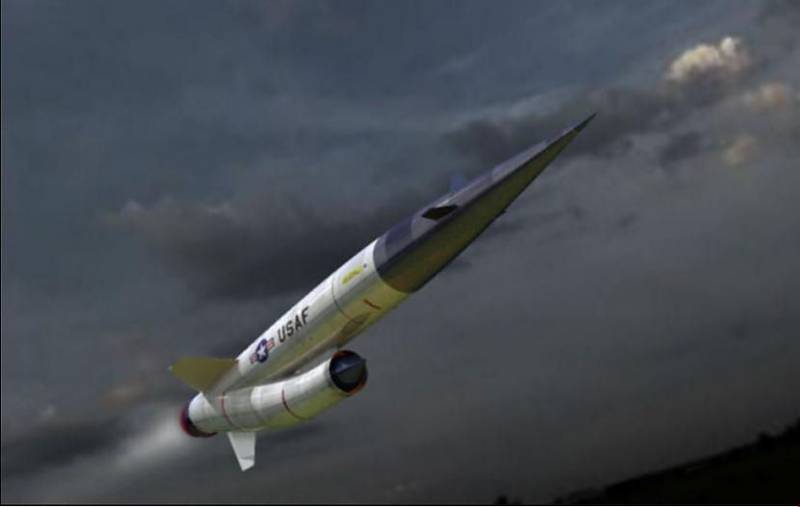
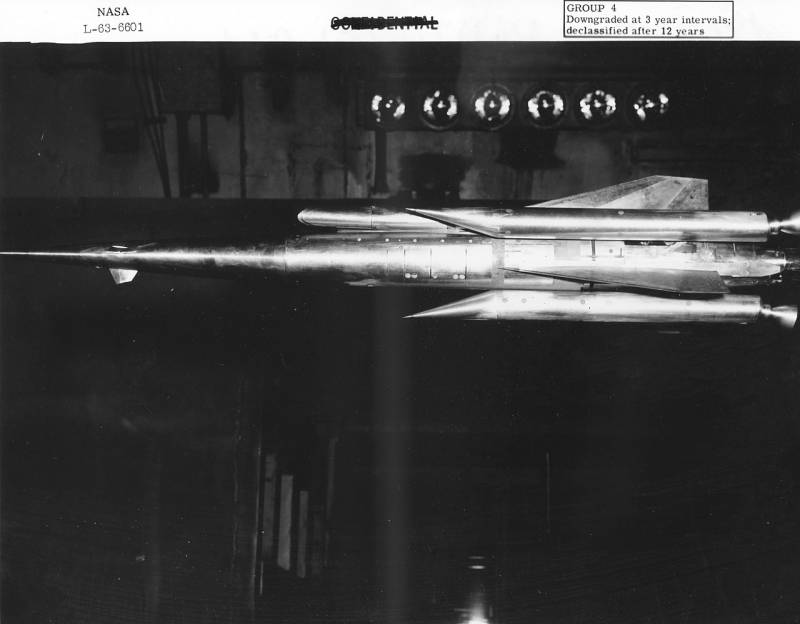
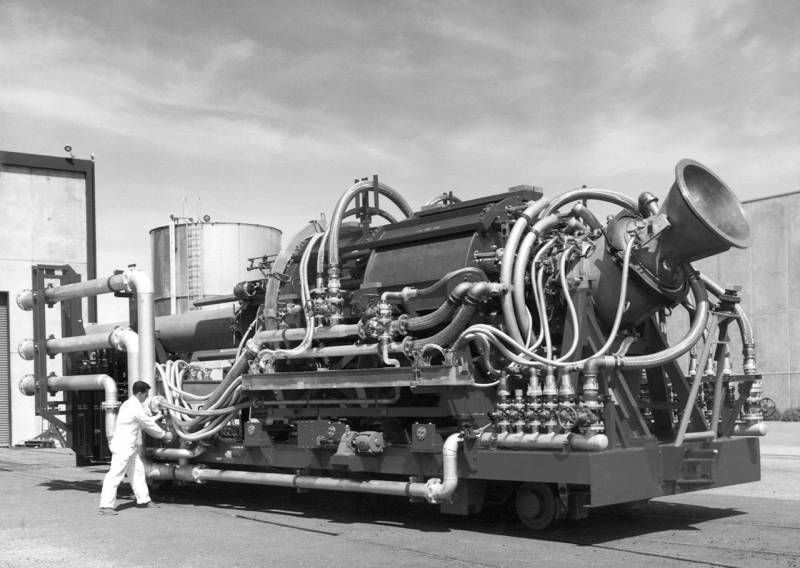
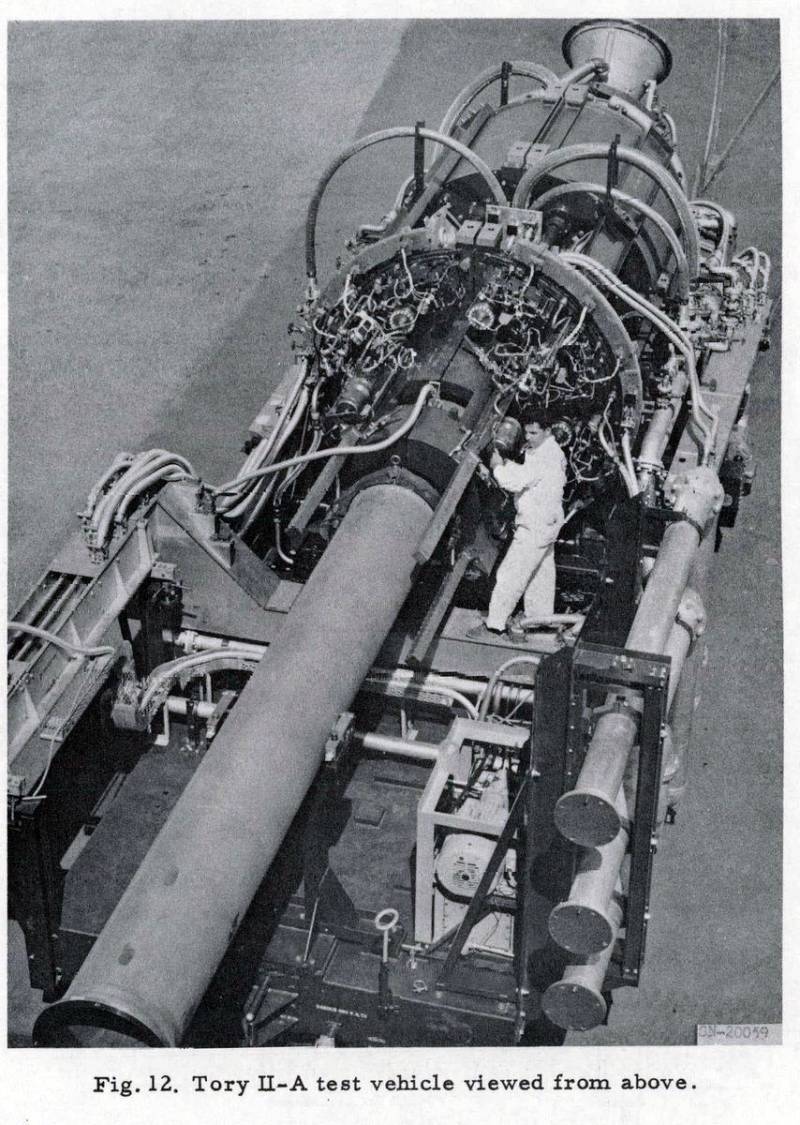
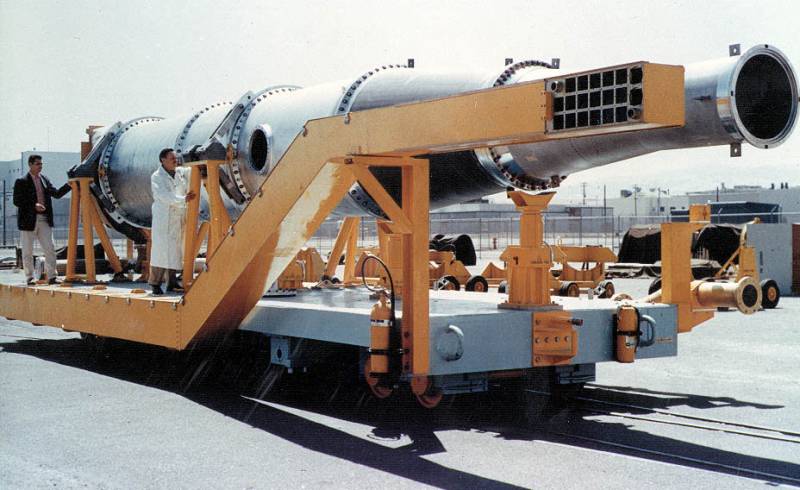
Information